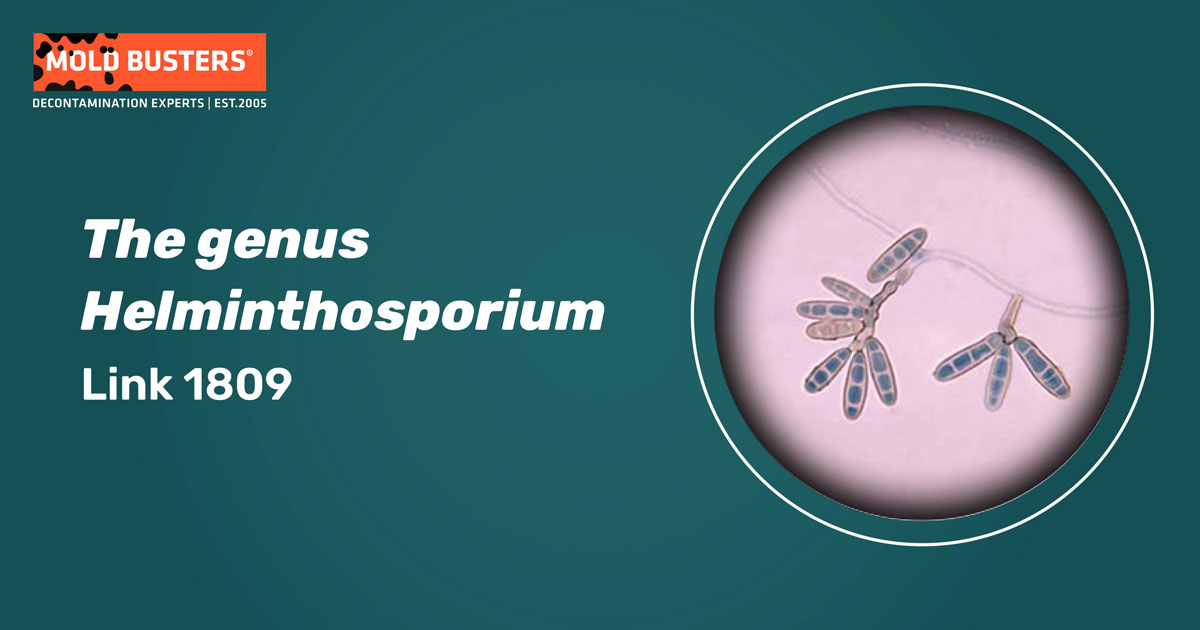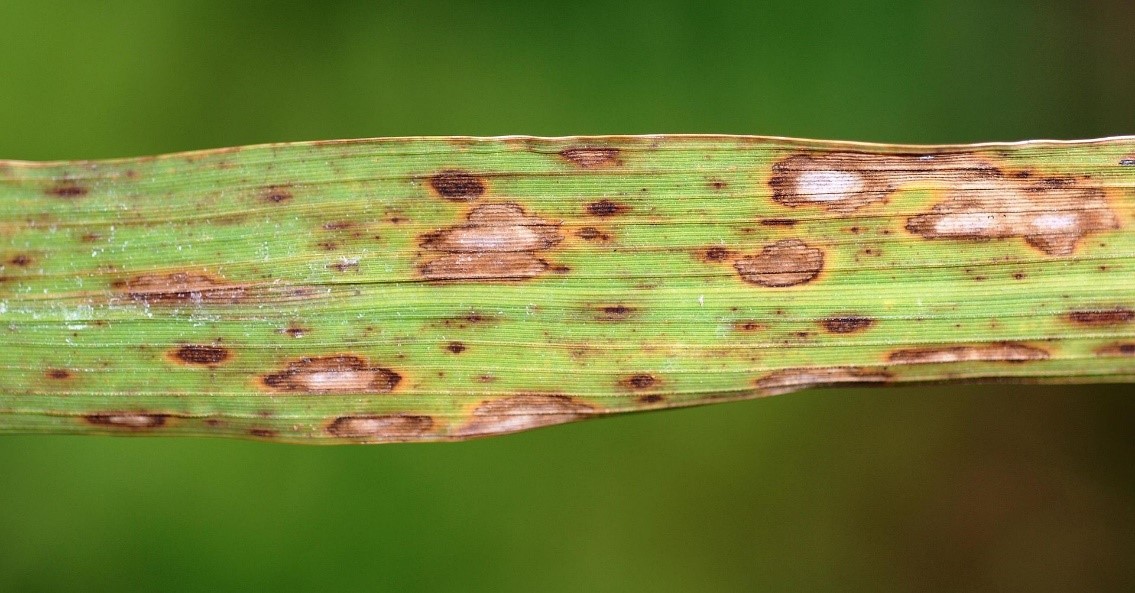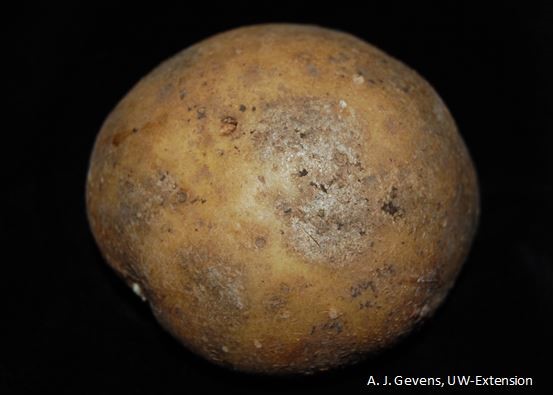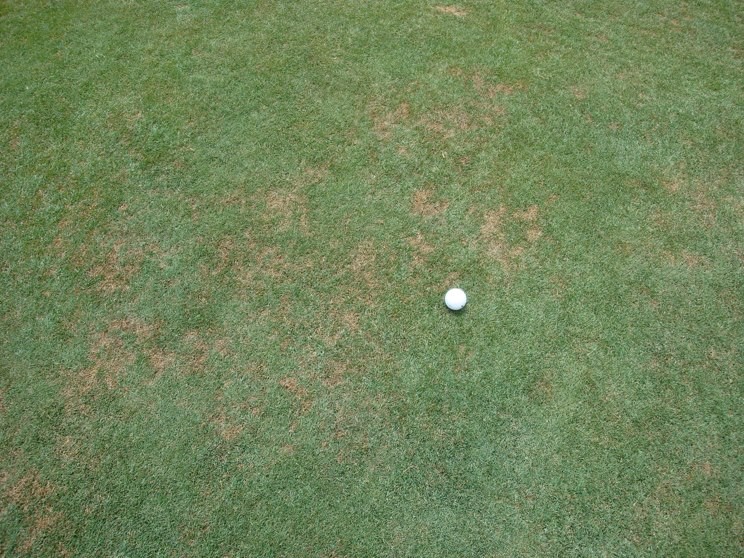Link 1809
What is Helminthosporium?
Helminthosporium is a fungal genus belonging to the order Pleopsporales. This genus reproduces asexually, and the fungi are dispersed through conidia (asexual spores). [3] Helminthosporium spp. are primarily saprobes, living on dead or decaying plant matter, but certain species can also infect economically important crop plants. [8]

Helminthosporium characteristics:
Helminthosporium spp. have septated hyphae. The color of conidiophores (spore-bearing structures) varies from brown to dark brown. Conidia are multicellular with six or more cells; they are solitary, large, elongated, and pale to dark brown. [6]
Helmithosporium species
The genus Helminthosporium was described in 1809. This genus became the repository for many newly-described species, only some of which were congeneric with the type species. Considering that the genus has many species and many of them have been assigned to other genera, we will mention only the most common species in this article. [1]
- Helminthosporium solani is the fungus that causes the Silver Scurf disease of potatoes.
- Helminthosporium gramineum causes discoloration on barley leaves. This type of disease is commonly called the yellow stripe.
- Cochliobolus carbonum, also known as maize leaf spot, is one of the most aggressive members of this genus, infecting many plant species. It is recognized as the pathogen of sweet corn, sorghum, and apple.
- Cochliobolus sativus causes foliar disease of wheat, which is usually called spot blotch; it significantly reduces grain yield and quality.
- Helminthosporium sativum causes discoloration on barley, wheat, and quack grass.
Helminthosporium mold
So far, there has been no case of infection caused by Helminthosporium in humans or animals. What is thought to be Helminthosporioum mold is usually Dreschslera sp., Bipolaris sp., or Exseohilum sp. molds. All four mentioned genera are under Pleosporales order and can be morphologically similar to some species from the Helminthosporioum genus.
Bipolaris sp., previously classified as Helminthosporium mold, can be commonly found in our homes. This fungus loves moist surfaces so that it can grow on walls or the bathroom ceiling. In addition, you can find it on different types of food, such as bread, corn, and fruits. This fungus can produce mycotoxins, which have serious adverse effects on animals and cause internal organs disfunction. In humans, this fungus can cause allergic reactions once inhaled and even cause more serious diseases such as phaeohyphomycosis. Spores of the fungus attach to the sinuses and start growing, which can induce very painful sensations. This kind of infection must be treated immediately, often combining anti-fungal medications and surgery. [9]
Where can Helminthosporium be found?
Helminthosporium species are common in warm and humid areas. They also grow on several crop species, especially on a maze. They are frequently associated with grass infections. Furthermore, Helminthosporium spp. can be found on rotting food items and vegetables. [2]
Helminthosporium leaf spot
Leaf spot is a general term for many diseases caused by different fungi. Leaf spot-causing fungi from the Helminthosporium genus can grow over a wide range of temperatures during the whole year. The most optimal periods for infections are fall and winter since these periods tend to have high humidity, and this is because they require winds and rainfall for conidia dispersal.
Disease symptoms are brown to purple lesions and spots, which can vary in size. As the infection progresses, expanded lesions with bleached centers that girdle the leaf blade appears (Fig. 1). Severely infected leaves turn purple or reddish-brown. This disease can be managed with the application of several different types of fungicides. [7]

Helminthosporium maydis, H.oryzae, H. turcikum are pathogens on cultivated and wild Poaceae spp. (grasses), palms, beans, and coffee plants. They are associated with leaf spots and blights. Their ability to cause devastating disease has occasionally resulted in significant economic loss. In addition, mycotoxins produced by these species contaminate animal fed and are toxic to domestic animals.
Helminthosporium solani is a plant pathogen that causes the disease known as the silver scurf of potatoes. The fungus causes a cosmetic effect on the tuber in the form of a surface blemish, which gives the tuber a dirty and unhealthy appearance (Fig. 2). This disease has become economically important since the food industry cannot use potatoes infected with the silver scurf. [4]

During the colder months in North America, fungi from the Bipolaris, Dreschlera, Curvularia, and Exserohilum genera can cause turfgrass disease. The symptoms severity of the turf disease depends on the pathogen and the weather conditions. Infected grass can have dark or white spots or patches (Fig. 3). This disease diminishes backyards and gardens aesthetics and produces a lot of spores, which can infect other plants. Additionally, a high amount of the spore inoculum can be unhealthy to immunocompromised allergic individuals. In such a case, the best thing to do is contact remediation professionals who can apply the proper fungicide treatment [10].


Did you know?
Only 11% of tested bedrooms in Canada didn’t have any mold type present?! Find out more exciting mold stats and facts on our mold statistics page.
References
- Alcorn, J. L. (1988). The Taxonomy of “Helminthosporium” Species. Annual Review of Phytopathology.
- Britannica “Helminthosporium”, T. E. (2021, July 13). Britannica. Retrieved from Encyclopedia Britannica
- Gould, A. B. (2009). Fungi: Plant Pathogenic. Encyclopedia of Microbiology.
- Iott, M. (2012). Helminthosporium solani, Soilborne Plant Pathogen Class Project.
- Kruys Å, E. O. (2006). Phylogenetic relationships of coprophilous Pleosporales (Dothideomycetes, Ascomycota), and the classification of some bitunicate taxa of unknown position.
- Larone, D. H. (1995). Medically Important Fungi – A Guide to Identification (3rd ed. ed.). Washington, D.C: ASM Press.
- L. Elliott, P. F. (2021, July 17). Helminthosporium Leaf Spot. Retrieved from edis.ifas.ufl.edu
- Rankovic, B. (2004). Sistematika Gljiva. Kragujevac .
- Rao, A. R.-S. (1989). Phaeohyphomycosis of the nasal sinuses caused by Bipolaris species.
- Windham, A. (1988). Turfgrass Diseases and Their Control. University of Tennessee Institute of Agriculture.

Get Special Gift: Industry-Standard Mold Removal Guidelines
Download the industry-standard guidelines that Mold Busters use in their own mold removal services, including news, tips and special offers:

Written by:
John Ward
Account Executive
Mold Busters
Fact checked by:
Michael Golubev
General Manager
Mold Busters
